YouTube
Webb moved for fueling #shorts 06-12-2021 06:44 PM CET
The James Webb Space Telescope, configured for flight, was moved from the cleanroom to the payload preparation facility for fuelling at Europe’s Spaceport in French Guiana on 11–12 November 2021. Webb will be loaded with propellants before being mounted on top of the rocket and then encapsulated by the Ariane 5 fairing. Webb will be the largest, most powerful telescope ever launched into space. As part of an international collaboration agreement, ESA is providing the telescope’s launch service using the Ariane 5 launch vehicle. Working with partners, ESA was responsible for the development and qualification of Ariane 5 adaptations for the Webb mission and for the procurement of the launch service by Arianespace. Webb is an international partnership between @NASA , ESA and the @Canadian Space Agency.
Find out more about Webb in ESA’s launch kit: https://bit.ly/ESAWebbToolKit Copyright: ESA / @CNES / @arianespace
★ Subscribe: http://bit.ly/ESAsubscribe and click twice on the bell button to receive our notifications.
Check out our full video catalog: http://bit.ly/SpaceInVideos
Follow us on Twitter: http://bit.ly/ESAonTwitter On Facebook: http://bit.ly/ESAonFacebook
On Instagram: http://bit.ly/ESAonInstagram On LinkedIn: https://bit.ly/ESAonLinkedIn
On Pinterest: https://bit.ly/ESAonPinterest On Flickr: http://bit.ly/ESA
On Flickr We are Europe’s gateway to space. Our mission is to shape the development of Europe’s space capability and ensure that investment in space continues to deliver benefits to the citizens of Europe and the world. Check out https://www.esa.int/ to get up to speed on everything space related.
Copyright information about our videos is available here: https://www.esa.int/ESA_Multimedia/Terms_and_Conditions #ESA #Webb #WebbFliesAriane
Flickr
The
James Webb Space Telescope was fuelled inside the payload preparation
facility at Europe’s Spaceport in French Guiana ahead of its launch on
Ariane 5.
Webb’s thrusters will use this propellant to make critical
course-corrections after separation from Ariane 5, to maintain its
prescribed orbit about one and a half million kilometres from Earth, and
to repoint the observatory and manage its momentum during operations.
Fuelling any satellite is a particularly delicate operation requiring
setup of the equipment and connections, fuelling, and then
pressurisation.
Webb’s propellant tanks were filled separately with 79.5 l of dinitrogen
tetroxide oxidiser and 159 l hydrazine. Oxidiser improves the burn
efficiency of the hydrazine fuel.
These propellants are extremely toxic so only a few specialists wearing
Self-Contained Atmospheric Protective Ensemble, or ‘scape’ suits,
remained in the dedicated fuelling hall for fuelling which took 10 days
and ended on 3 December.
The next steps will start soon for ‘combined operations’. This is when
specialists working separately to prepare Webb and Ariane 5 will come
together as one team. They will place Webb atop its Ariane 5 launch
vehicle and encapsulate it inside Ariane 5’s fairing.
Then, no longer visible, Webb, joined with its Ariane 5 launch vehicle
will be transferred to the Final Assembly building for the final
preparations before launch.
Webb will be the largest, most powerful telescope ever launched into
space. As part of an international collaboration agreement, ESA is
providing the telescope’s launch service using the Ariane 5 launch
vehicle. Working with partners, ESA was responsible for the development
and qualification of Ariane 5 adaptations for the Webb mission and for
the procurement of the launch service by Arianespace.
Webb is an international partnership between NASA, ESA and the Canadian Space Agency (CSA).
Find out more about Webb in ESA’s launch kit and interactive brochure.
Credits: ESA/CNES/Arianespace/Optique Vidéo du CSG – P PironWebb fuelled for launch
06-12-2021 05:25 PM CET
europeanspaceagency posted a photo:

The James Webb Space Telescope was fuelled inside the payload
preparation facility at Europe’s Spaceport in French Guiana ahead of its
launch on Ariane 5.
Webb’s thrusters will use this propellant to make critical
course-corrections after separation from Ariane 5, to maintain its
prescribed orbit about one and a half million kilometres from Earth, and
to repoint the observatory and manage its momentum during operations.
Fuelling any satellite is a particularly delicate operation requiring
setup of the equipment and connections, fuelling, and then
pressurisation.
Webb’s propellant tanks were filled separately with 79.5 l of dinitrogen
tetroxide oxidiser and 159 l hydrazine. Oxidiser improves the burn
efficiency of the hydrazine fuel.
These propellants are extremely toxic so only a few specialists wearing
Self-Contained Atmospheric Protective Ensemble, or ‘scape’ suits,
remained in the dedicated fuelling hall for fuelling which took 10 days
and ended on 3 December.
The next steps will start soon for ‘combined operations’. This is when
specialists working separately to prepare Webb and Ariane 5 will come
together as one team. They will place Webb atop its Ariane 5 launch
vehicle and encapsulate it inside Ariane 5’s fairing.
Then, no longer visible, Webb, joined with its Ariane 5 launch vehicle
will be transferred to the Final Assembly building for the final
preparations before launch.
Webb will be the largest, most powerful telescope ever launched into
space. As part of an international collaboration agreement, ESA is
providing the telescope’s launch service using the Ariane 5 launch
vehicle. Working with partners, ESA was responsible for the development
and qualification of Ariane 5 adaptations for the Webb mission and for
the procurement of the launch service by Arianespace.
Webb is an international partnership between NASA, ESA and the Canadian Space Agency (CSA).
Find out more about Webb in ESA’s launch kit and interactive brochure.
Credits: ESA/CNES/Arianespace/Optique Vidéo du CSG – P PironWebb fuelled for launch
06-12-2021 05:25 PM CET
europeanspaceagency posted a photo:

The James Webb Space Telescope was fuelled inside the payload
preparation facility at Europe’s Spaceport in French Guiana ahead of its
launch on Ariane 5.
Webb’s thrusters will use this propellant to make critical
course-corrections after separation from Ariane 5, to maintain its
prescribed orbit about one and a half million kilometres from Earth, and
to repoint the observatory and manage its momentum during operations.
Fuelling any satellite is a particularly delicate operation requiring
setup of the equipment and connections, fuelling, and then
pressurisation.
Webb’s propellant tanks were filled separately with 79.5 l of dinitrogen
tetroxide oxidiser and 159 l hydrazine. Oxidiser improves the burn
efficiency of the hydrazine fuel.
These propellants are extremely toxic so only a few specialists wearing
Self-Contained Atmospheric Protective Ensemble, or ‘scape’ suits,
remained in the dedicated fuelling hall for fuelling which took 10 days
and ended on 3 December.
The next steps will start soon for ‘combined operations’. This is when
specialists working separately to prepare Webb and Ariane 5 will come
together as one team. They will place Webb atop its Ariane 5 launch
vehicle and encapsulate it inside Ariane 5’s fairing.
Then, no longer visible, Webb, joined with its Ariane 5 launch vehicle
will be transferred to the Final Assembly building for the final
preparations before launch.
Webb will be the largest, most powerful telescope ever launched into
space. As part of an international collaboration agreement, ESA is
providing the telescope’s launch service using the Ariane 5 launch
vehicle. Working with partners, ESA was responsible for the development
and qualification of Ariane 5 adaptations for the Webb mission and for
the procurement of the launch service by Arianespace.
Webb is an international partnership between NASA, ESA and the Canadian Space Agency (CSA).
Find out more about Webb in ESA’s launch kit and interactive brochure.
Credits: ESA/CNES/Arianespace/Optique Vidéo du CSG – P PironWebb fuelled for launch
06-12-2021 05:25 PM CET
europeanspaceagency posted a photo:

The James Webb Space Telescope was fuelled inside the payload
preparation facility at Europe’s Spaceport in French Guiana ahead of its
launch on Ariane 5.
Webb’s thrusters will use this propellant to make critical
course-corrections after separation from Ariane 5, to maintain its
prescribed orbit about one and a half million kilometres from Earth, and
to repoint the observatory and manage its momentum during operations.
Fuelling any satellite is a particularly delicate operation requiring
setup of the equipment and connections, fuelling, and then
pressurisation.
Webb’s propellant tanks were filled separately with 79.5 l of dinitrogen
tetroxide oxidiser and 159 l hydrazine. Oxidiser improves the burn
efficiency of the hydrazine fuel.
These propellants are extremely toxic so only a few specialists wearing
Self-Contained Atmospheric Protective Ensemble, or ‘scape’ suits,
remained in the dedicated fuelling hall for fuelling which took 10 days
and ended on 3 December.
The next steps will start soon for ‘combined operations’. This is when
specialists working separately to prepare Webb and Ariane 5 will come
together as one team. They will place Webb atop its Ariane 5 launch
vehicle and encapsulate it inside Ariane 5’s fairing.
Then, no longer visible, Webb, joined with its Ariane 5 launch vehicle
will be transferred to the Final Assembly building for the final
preparations before launch.
Webb will be the largest, most powerful telescope ever launched into
space. As part of an international collaboration agreement, ESA is
providing the telescope’s launch service using the Ariane 5 launch
vehicle. Working with partners, ESA was responsible for the development
and qualification of Ariane 5 adaptations for the Webb mission and for
the procurement of the launch service by Arianespace.
Webb is an international partnership between NASA, ESA and the Canadian Space Agency (CSA).
Find out more about Webb in ESA’s launch kit and interactive brochure.
Credits: ESA/CNES/Arianespace/Optique Vidéo du CSG – P PironWebb fuelled for launch
06-12-2021 05:25 PM CET
europeanspaceagency posted a photo:
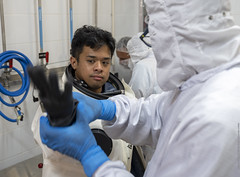
The James Webb Space Telescope was fuelled inside the payload
preparation facility at Europe’s Spaceport in French Guiana ahead of its
launch on Ariane 5.
Webb’s thrusters will use this propellant to make critical
course-corrections after separation from Ariane 5, to maintain its
prescribed orbit about one and a half million kilometres from Earth, and
to repoint the observatory and manage its momentum during operations.
Fuelling any satellite is a particularly delicate operation requiring
setup of the equipment and connections, fuelling, and then
pressurisation.
Webb’s propellant tanks were filled separately with 79.5 l of dinitrogen
tetroxide oxidiser and 159 l hydrazine. Oxidiser improves the burn
efficiency of the hydrazine fuel.
These propellants are extremely toxic so only a few specialists wearing
Self-Contained Atmospheric Protective Ensemble, or ‘scape’ suits,
remained in the dedicated fuelling hall for fuelling which took 10 days
and ended on 3 December.
The next steps will start soon for ‘combined operations’. This is when
specialists working separately to prepare Webb and Ariane 5 will come
together as one team. They will place Webb atop its Ariane 5 launch
vehicle and encapsulate it inside Ariane 5’s fairing.
Then, no longer visible, Webb, joined with its Ariane 5 launch vehicle
will be transferred to the Final Assembly building for the final
preparations before launch.
Webb will be the largest, most powerful telescope ever launched into
space. As part of an international collaboration agreement, ESA is
providing the telescope’s launch service using the Ariane 5 launch
vehicle. Working with partners, ESA was responsible for the development
and qualification of Ariane 5 adaptations for the Webb mission and for
the procurement of the launch service by Arianespace.
Webb is an international partnership between NASA, ESA and the Canadian Space Agency (CSA).
Find out more about Webb in ESA’s launch kit and interactive brochure.
Credits: ESA/CNES/Arianespace/Optique Vidéo du CSG – P PironWebb fuelled for launch
06-12-2021 05:25 PM CET
europeanspaceagency posted a photo:
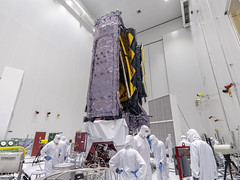
The James Webb Space Telescope was fuelled inside the payload
preparation facility at Europe’s Spaceport in French Guiana ahead of its
launch on Ariane 5.
Webb’s thrusters will use this propellant to make critical
course-corrections after separation from Ariane 5, to maintain its
prescribed orbit about one and a half million kilometres from Earth, and
to repoint the observatory and manage its momentum during operations.
Fuelling any satellite is a particularly delicate operation requiring
setup of the equipment and connections, fuelling, and then
pressurisation.
Webb’s propellant tanks were filled separately with 79.5 l of dinitrogen
tetroxide oxidiser and 159 l hydrazine. Oxidiser improves the burn
efficiency of the hydrazine fuel.
These propellants are extremely toxic so only a few specialists wearing
Self-Contained Atmospheric Protective Ensemble, or ‘scape’ suits,
remained in the dedicated fuelling hall for fuelling which took 10 days
and ended on 3 December.
The next steps will start soon for ‘combined operations’. This is when
specialists working separately to prepare Webb and Ariane 5 will come
together as one team. They will place Webb atop its Ariane 5 launch
vehicle and encapsulate it inside Ariane 5’s fairing.
Then, no longer visible, Webb, joined with its Ariane 5 launch vehicle
will be transferred to the Final Assembly building for the final
preparations before launch.
Webb will be the largest, most powerful telescope ever launched into
space. As part of an international collaboration agreement, ESA is
providing the telescope’s launch service using the Ariane 5 launch
vehicle. Working with partners, ESA was responsible for the development
and qualification of Ariane 5 adaptations for the Webb mission and for
the procurement of the launch service by Arianespace.
Webb is an international partnership between NASA, ESA and the Canadian Space Agency (CSA).
Find out more about Webb in ESA’s launch kit and interactive brochure.
Credits: ESA/CNES/Arianespace/Optique Vidéo du CSG – P PironGalileo satellites 27-28 liftoff
06-12-2021 10:37 AM CET
europeanspaceagency posted a photo:

Europe’s largest satellite constellation has grown even bigger,
following the launch of two more Galileo navigation satellites by Soyuz
launcher from Europe’s Spaceport in French Guiana on 5 December. Galileo
satellites 27-28 add to an existing 26-satellite constellation in
orbit, providing the world’s most precise satnav positioning to more
than 2.3 billion users around the globe.
Soyuz launcher VS-26, operated by Arianespace and commissioned by ESA,
lifted off with the pair of 715 kg satellites from French Guiana on 5
December at 01:19 CET. All the Soyuz stages performed as planned, with
the Fregat upper stage releasing the satellites into their target orbit
close to 23 525 km altitude, around 3 hours and 54 minutes after
liftoff.
The satellites will spend the coming weeks being manoeuvred into their
final working orbit at 23 222 km using their onboard thrusters, at the
same time as their onboard systems are gradually checked out for
operational use – known as the Launch and Early Operations Phase.
Credits: ESA/CNES/Arianespace/Optique Vidéo du CSG – S MartinGalileo satellites 27-28 liftoff
06-12-2021 10:37 AM CET
europeanspaceagency posted a photo:

Europe’s largest satellite constellation has grown even bigger,
following the launch of two more Galileo navigation satellites by Soyuz
launcher from Europe’s Spaceport in French Guiana on 5 December. Galileo
satellites 27-28 add to an existing 26-satellite constellation in
orbit, providing the world’s most precise satnav positioning to more
than 2.3 billion users around the globe.
Soyuz launcher VS-26, operated by Arianespace and commissioned by ESA,
lifted off with the pair of 715 kg satellites from French Guiana on 5
December at 01:19 CET. All the Soyuz stages performed as planned, with
the Fregat upper stage releasing the satellites into their target orbit
close to 23 525 km altitude, around 3 hours and 54 minutes after
liftoff.
The satellites will spend the coming weeks being manoeuvred into their
final working orbit at 23 222 km using their onboard thrusters, at the
same time as their onboard systems are gradually checked out for
operational use – known as the Launch and Early Operations Phase.
Credits: ESA/CNES/Arianespace/Optique Vidéo du CSG – S MartinSoyuz launcher VS-26
06-12-2021 10:37 AM CET
europeanspaceagency posted a photo:

Europe’s largest satellite constellation has grown even bigger,
following the launch of two more Galileo navigation satellites by Soyuz
launcher from Europe’s Spaceport in French Guiana on 5 December. Galileo
satellites 27-28 add to an existing 26-satellite constellation in
orbit, providing the world’s most precise satnav positioning to more
than 2.3 billion users around the globe.
Soyuz launcher VS-26, operated by Arianespace and commissioned by ESA,
lifted off with the pair of 715 kg satellites from French Guiana on 5
December at 01:19 CET. All the Soyuz stages performed as planned, with
the Fregat upper stage releasing the satellites into their target orbit
close to 23 525 km altitude, around 3 hours and 54 minutes after
liftoff.
The satellites will spend the coming weeks being manoeuvred into their
final working orbit at 23 222 km using their onboard thrusters, at the
same time as their onboard systems are gradually checked out for
operational use – known as the Launch and Early Operations Phase.
Credits: ESA/CNES/Arianespace/Optique Vidéo du CSG – P PironSoyuz launcher VS-26
06-12-2021 10:37 AM CET
europeanspaceagency posted a photo:

Europe’s largest satellite constellation has grown even bigger,
following the launch of two more Galileo navigation satellites by Soyuz
launcher from Europe’s Spaceport in French Guiana on 5 December. Galileo
satellites 27-28 add to an existing 26-satellite constellation in
orbit, providing the world’s most precise satnav positioning to more
than 2.3 billion users around the globe.
Soyuz launcher VS-26, operated by Arianespace and commissioned by ESA,
lifted off with the pair of 715 kg satellites from French Guiana on 5
December at 01:19 CET. All the Soyuz stages performed as planned, with
the Fregat upper stage releasing the satellites into their target orbit
close to 23 525 km altitude, around 3 hours and 54 minutes after
liftoff.
The satellites will spend the coming weeks being manoeuvred into their
final working orbit at 23 222 km using their onboard thrusters, at the
same time as their onboard systems are gradually checked out for
operational use – known as the Launch and Early Operations Phase.
Credits: ESA/CNES/Arianespace/Optique Vidéo du CSG – P PironSoyuz launcher VS-26
06-12-2021 10:37 AM CET
europeanspaceagency posted a photo:

Europe’s largest satellite constellation has grown even bigger,
following the launch of two more Galileo navigation satellites by Soyuz
launcher from Europe’s Spaceport in French Guiana on 5 December. Galileo
satellites 27-28 add to an existing 26-satellite constellation in
orbit, providing the world’s most precise satnav positioning to more
than 2.3 billion users around the globe.
Soyuz launcher VS-26, operated by Arianespace and commissioned by ESA,
lifted off with the pair of 715 kg satellites from French Guiana on 5
December at 01:19 CET. All the Soyuz stages performed as planned, with
the Fregat upper stage releasing the satellites into their target orbit
close to 23 525 km altitude, around 3 hours and 54 minutes after
liftoff.
The satellites will spend the coming weeks being manoeuvred into their
final working orbit at 23 222 km using their onboard thrusters, at the
same time as their onboard systems are gradually checked out for
operational use – known as the Launch and Early Operations Phase.
Credits: ESA/CNES/Arianespace/Optique Vidéo du CSG – P PironSoyuz launcher VS-26
06-12-2021 10:37 AM CET
europeanspaceagency posted a photo:
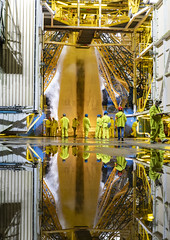
Europe’s largest satellite constellation has grown even bigger,
following the launch of two more Galileo navigation satellites by Soyuz
launcher from Europe’s Spaceport in French Guiana on 5 December. Galileo
satellites 27-28 add to an existing 26-satellite constellation in
orbit, providing the world’s most precise satnav positioning to more
than 2.3 billion users around the globe.
Soyuz launcher VS-26, operated by Arianespace and commissioned by ESA,
lifted off with the pair of 715 kg satellites from French Guiana on 5
December at 01:19 CET. All the Soyuz stages performed as planned, with
the Fregat upper stage releasing the satellites into their target orbit
close to 23 525 km altitude, around 3 hours and 54 minutes after
liftoff.
The satellites will spend the coming weeks being manoeuvred into their
final working orbit at 23 222 km using their onboard thrusters, at the
same time as their onboard systems are gradually checked out for
operational use – known as the Launch and Early Operations Phase.
Credits: ESA/CNES/Arianespace/Optique Vidéo du CSG – P Piron







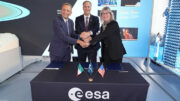
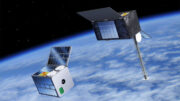
Be the first to comment on "European Space Agency YouTube and Flickr Update"